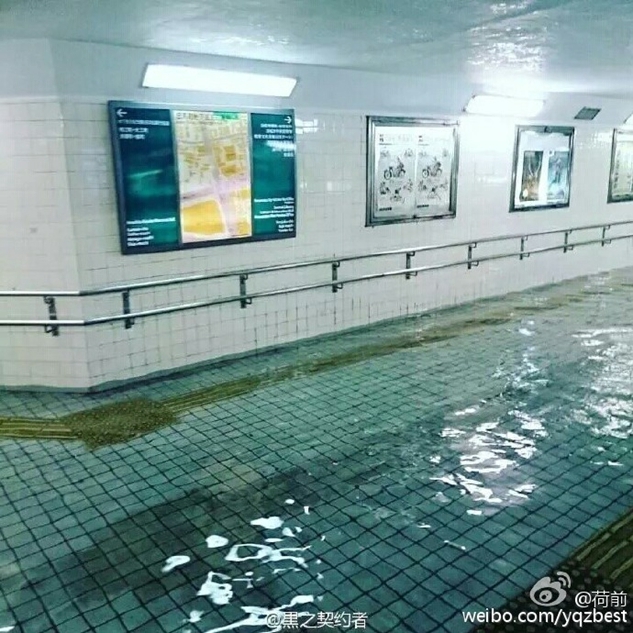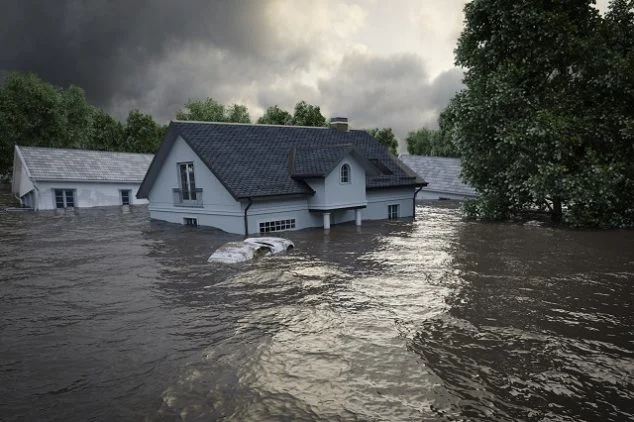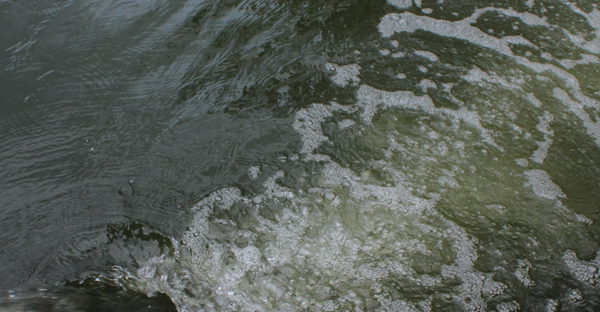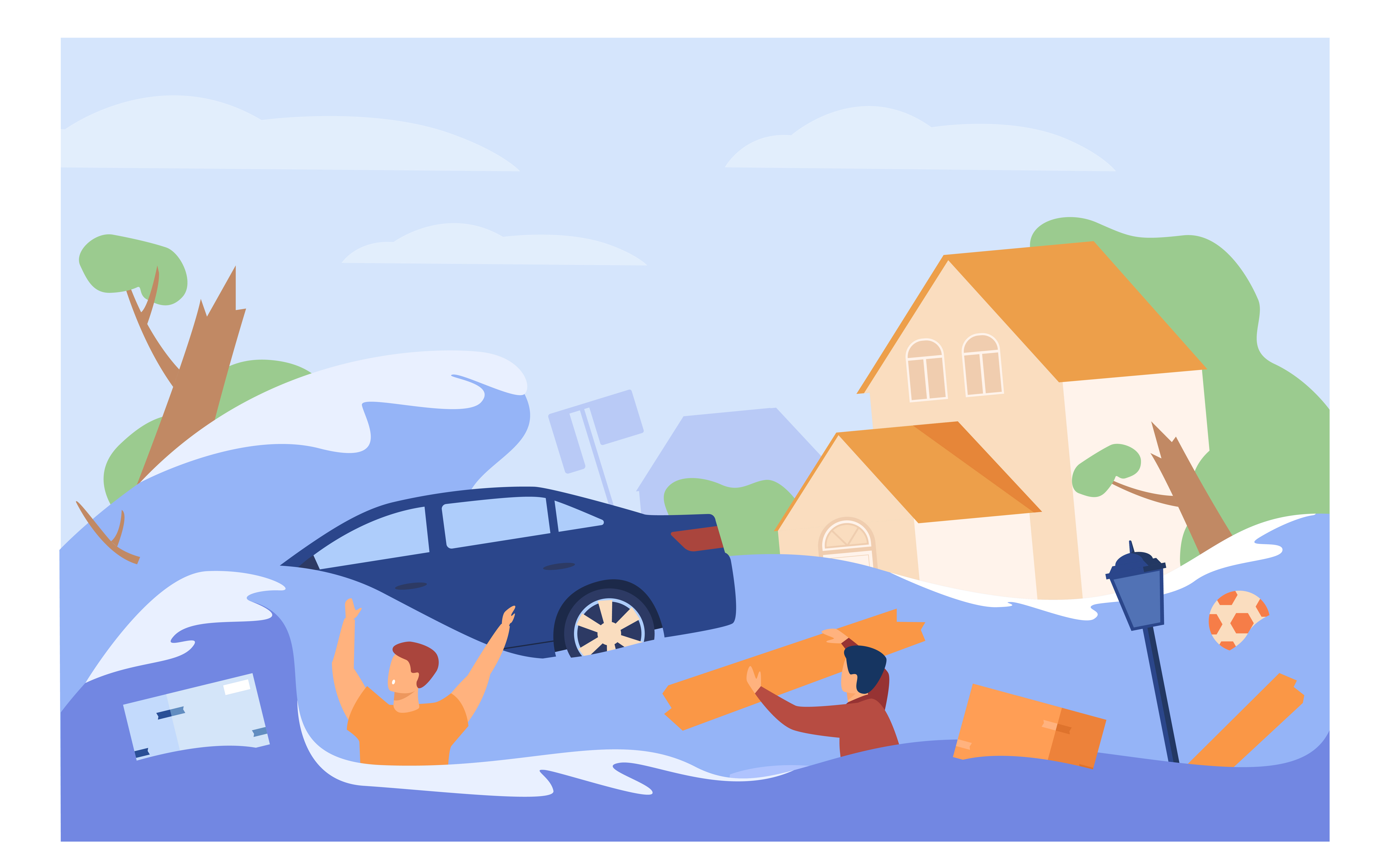↪ WHAT IS A FLOOD? ↩
Flood is an overflow of water that submerges land that is usually dry. Floods often cause damage to homes and businesses if they are in the natural floodplains of rivers. Standing flood waters can also spread infectious diseases, contain chemical hazards, and cause injuries. The Environment Agency is responsible for flood risk management activities on main rivers, regulating reservoir safety, and providing river flood warnings. It has powers to undertake work on main rivers to fix flooding issues. In addition to the risks of drowning, electrocution and injury that are present in the aftermath of a flood, contamination is a serious threat to your health. Common causes of flood : Heavy rainfall, Overflowing of Rivers and lakes, Melting of Glaciers, Cataclysmic Events and Human-made causes.
Flash floods are particularly dangerous. The centers for Disease control report that over half of all flood-related drownings occur when a vehicle is driven into hazardous floodwater. According to the National Weather Services, a mere 6 inches of fast-moving flood water can knock over an adult. It just takes 12 inches of rushing water to carry away a small car, while 2 feet of rushing water can carry away most vehicles.
When it comes to flooding emergencies, Blackwater Floods are the most dangerous and the most destructive. Because of the grossly unsanitary conditions of the water, porous and absorbent items such as carpets, upholstery and drywall are often unsalvageable. Contact with Greywater or Blackwater can cause water-borne diseases, such as typhoid fever, cholera, leptospirosis and hepatitis A. Vector-borne diseases, such as malaria, dengue and dengue haemorrhagic fever, yellow fever, and West Nile Fever.

Clearwater that does not post an immediate health threat is known as clean water. Clean water floods can result from malfunctioning appliances, toilet holding tanks, and melting snow and rainwater. Clean water home floods are generally safe for you to clean up yourself, but standing clean water can become grey water in as little as 48 hours.

Greywater also known as sullage, refers to wastewater that is not contaminated with fecal matter. It generally contains fewer pathogens than blackwater and can be reused for non-potable purposes, such as toilet flushing. Grey water still contains small amounts of contaminants and can induce illness if ingested. Grey water cleanup must begin immediately.

Blackwater refers to wastewater contaminated with human waste. The citywide floodwaters we see on television are blackwater. Raw sewage is classified as blackwater. It is a haven for dangerous bacteria and pathogens that must fully decompose before being released into the environment. It can also be contaminated with dissolved chemicals and particulate matter, making contact even more dangerous.
Common warning signs include intense rainfall, dam or levee failure as well as other events such as slow moving tropical storms and early snowmelt can all contribute to flooding, whether you live in a flood zone or not. Flash flooding occurs within 6 hours of the rain event. Flooding is a longer term event and may last a week or more. Flooding along rivers is a natural and inevitable part of life.
DID YOU KNOW? The biggest rainfall in a day occurred with the passage of Cyclone Denise in Foc-Foc, La Réunion, an island in the southern Indian Ocean. Some 1.825 meters (71.8 inches) of rain fell over 24 hours, from January 7 to 8, 1966. In 2015, flash flooding killed 129 people. The majority died in cars as they tried to drive through fast moving waters. These raging waters cause extreme destruction; destroying roads, washing away homes, and rising faster than people can react. If enough rain falls fast enough, any place can have a flash flood.
HOW CAN WE MITIGATE A FLOOD?
Flood prevention decreases the potential risk of flood damage to buildings and also reduces the severity of flood damage. — for example planning and zoning, floodplain management, discouraging growth in high risk flood zones or offering outreach and education in a neighborhood can be examples of mitigation. Examples of homeowners mitigation can involve flood insurance purchases.
The approaches to flood mitigation fall into two categories: structural and non-structural. The restoration of landscapes mitigates damage by structural types of mitigation. It includes floodwalls, fur-trees, levees and routes of evacuation. Non-structural action prevents damage by removing individuals and properties from danger zones. They include higher structures, buyouts, permanent relocation, zoning, subdivision and construction codes. Structural solutions have long lost prominence because of the collapse of old dams and floodgates.
Make an Emergency Plan: Create a family emergency communications plan that has an out-of-state contact. Plan where to meet if you get separated. Make a supply kit that includes enough food and water for several days, a flashlight and a whistle. Don’t forget to include your pet in your emergency plan. Remember that some evacuation shelters do not accept pets. Click here to know how to make an emergency plan
Build an emergency kit with the supplies you will need if you have to quickly evacuate your home. Gather supplies, including non-perishable foods, cleaning supplies, and water for several days, in case you must leave immediately. It is recommended that there is at least 3 days’ worth of supplies on hand, including one gallon per day for each person and pet. Click here to know how to make an emergency kit
WHAT DO I NEED TO DO TO SURVIVE A FLOOD?
Become familiar with the land around you. Learn whether your area is flood prone occur in your area by contacting local officials.
Go to the safe location that you have identified with your family. If you are not able to find a shelter in place, remember to bring items that can help you and others from COVID-19, such as sanitizers that contain at least 60 percent alcohol, wash your face regularly.
If you are told to evacuate (Bring your pets or animals), do so immediately. Never drive around barricades. Local responders use them to safely direct traffic out of flooded areas. If your car is trapped in rapid moving water, stay inside. If water is rising inside the car get on the roof.
Listen to EAS, NOAA Weather Radio or local alerting systems for current emergency information and instructions regarding flooding and COVID-19.
Turn off the power and water mains if instructed to do so by local authorities.
Boil tap water until water sources have been declared safe.
Avoid contact with floodwater. It may be contaminated with sewage or contain dangerous insects or animals.
Continue listening to local news or a NOAA Weather Radio for updated information and instructions.
Don’t use gas or electrical appliances that have been flooded.
Staying Safe outdoors
Don't walk, swim or drive through floodwater. Just six inches of fast-flowing water can knock you over and two feet will float a car.
If caught on a flooded road with rapidly rising waters, get out of the car quickly and move to higher ground.
Don't walk on beaches or riverbanks and Don’t allow children to play in or near flood water.
Avoid contact with floodwater. It may be contaminated with sewage or contain dangerous insects or animals.
Stay out of areas subject to flooding. Underpasses, dips, low spots, canyons, washes, etc. can become filled with water.
Let friends and family know you’re safe. Register yourself as safe on the Safe and Well website
If evacuated, return only when authorities say it is safe to do so.
Continue listening to local news or a NOAA Weather Radio for updated information and instructions.
Keep children and pets away from hazardous sites and floodwater.
If power lines are down outside your home, do not step in puddles or standing water. Report them immediately to the power company.
If any gas or electrical appliances were flooded, don’t use them until they have been checked for safety.
Dispose of any food that has come into contact with flood water.
EMERGENCY HOTLINES
911
Truck Lines :
911-506162636465
Operations Center :
(02) 8911-1406
(02) 8912-2665
(02) 8912-5668
(02) 8911-1873
Truck lines :
(02) 8931-8101 to 07
Disaster Response Unit :
(02) 8856-3665
(02) 8852-8081
Text Hotline :
0918-912-2813
Hotline :
143
Disaster Management Office :
132 (Manager)
133 (Radio Room)
134 (Staff)
Emergency Hotline :
117
(02) 8722-0650
Text Hotline :
0917-847-5757
Direct Line :
(02) 8426-0219
(02) 8426-0246
REFERENCES & ADDITIONAL INFORMATION
Floods | Ready.gov (2020) Retrieved 11 October 2020, from https://www.ready.gov/floods
Why A Flood is Dangerous | Roto-Rooter Blog. (2020). Retrieved 12 October 2020, from https://www.rotorooter.com/blog/flooding/dangers-of-flooding-water/
Eye On Calderdale. (2020). Retrieved 13 October 2020, from https://eyeoncalderdale.com/who-has-responsibility-in-a-flood
What is a Flood? | What Causes a Flood? | Flooding | Earth Networks. (2020). Retrieved 13 October 2020, from https://www.earthnetworks.com/flooding/
WHO | Flooding and communicable diseases fact sheet. (2020). Retrieved 13 October 2020, from https://www.who.int/hac/techguidance/ems/flood_cds/en/
Floods. (2020). Retrieved 15 October 2020, from https://www.weather.gov/pbz/floods#:~:text=Flash%20flooding%20occurs%20within%206,last%20a%20week%20or%20more..
Nebraska Department of Natural Resources (NeDNR). (2016). Flood Mitigation | Department of Natural Resources. [online] Available at: https://dnr.nebraska.gov/floodplain/flood-mitigation [Accessed Oct. 2020].
Ncsl.org. (2019). Flood Mitigation. [online] Available at: https://www.ncsl.org/research/environment-and-natural-resources/flood-mitigation.aspx [Accessed Oct. 2020].

